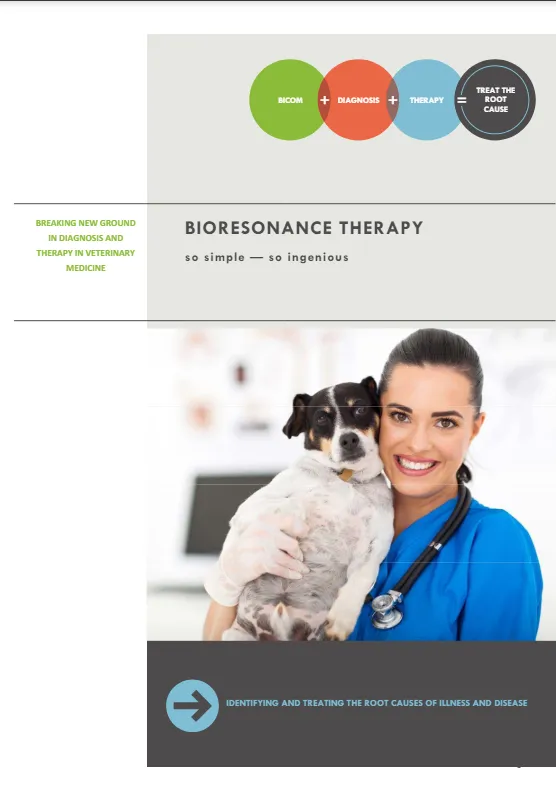BICOM® Bioresonance
Stress-free for pets and pet owners Suitable for all types of animals
There are many dogs , cats and horses suffering from health problems worldwide.
Be it problems with the musculoskeletal system, allergies and food intolerances or chronic diseases.
Sometimes, as an animal owner, you are at a loss when you can’t get any further with conventional therapy methods.
Like acupuncture or homeopathy, bioresonance belongs to the field of complementary medicine and is intended to be a useful supplement to conventional medicine.
It works with the body’s own wavelength of the four-legged friend, is used without medication and is painless to use.
Of course, not all health problems can be resolved with bioresonance. It is best to talk to a veterinarian or animal naturopath.
With our therapist finder you can find the nearest practice that can offer you BICOM® bioresonance.
Pain-free testing and therapy
Treatment with the BICOM® device is painless and stress-free. Especially sensitive animals feel very comfortable and it often happens that they completely relax and come to rest during the therapy.
Bioresonance has no harmful side effects and is used without medication.
Occasionally, initial aggravations, in what is known as the body’s initial reaction, can occur. However, these fade away after a short time.
What Pet Owners are saying..

Bioresonance Allergy Treatment: Safe & Effective Relief
Bioresonance Allergy Treatment: A Drug-Free Way to Relief
Allergies affect millions of people worldwide, causing discomfort and disrupting daily life. From seasonal pollen allergies to food intolerances and skin reactions, allergic symptoms can range from mild to severe. Many individuals rely on antihistamines, steroids, or immunotherapy to manage their symptoms, but these treatments often come with side effects and do not address the root cause of allergies.
For those seeking a natural and non-invasive alternative, bioresonance allergy treatment is emerging as a promising option. This therapy works by rebalancing the body's energy field, helping to reduce allergic reactions over time without the need for medication.
Understanding Allergies and Their Effects
An allergy occurs when the immune system mistakenly identifies a harmless substance as a threat. This overreaction triggers the release of histamines, causing symptoms such as:
Sneezing, nasal congestion, and a runny nose
Itchy, watery, and red eyes
Skin rashes, eczema, or hives
Digestive discomfort, bloating, or nausea
Fatigue, headaches, and brain fog
While some allergic reactions are mild, others can be severe and even life-threatening, such as anaphylaxis. Managing allergies effectively requires identifying the root cause and finding a sustainable solution beyond symptom relief.
What is Bioresonance Allergy Treatment?
Bioresonance therapy is a non-invasive technique that uses electromagnetic frequencies to detect and neutralize allergic responses. Every substance, including allergens, has a unique energy signature. When an allergen disrupts the body's natural energy balance, it can lead to an immune response.
This therapy works in three key steps:
1. Detection of Allergic Reactions – A bioresonance device scans the body to identify specific allergens causing stress.
2. Energy Rebalancing – The machine sends corrective frequencies to neutralize the body's hypersensitivity.
3. Building Up the Immune System – Over time, the body adapts, reducing the severity and frequency of allergic responses.
Unlike conventional treatments that suppress symptoms, bioresonance allergy treatment aims to retrain the immune system for long-term relief.
Scientific Basis and Research on Bioresonance Therapy
Although bioresonance therapy is still considered an alternative treatment, some studies and clinical reports suggest that it may be effective for allergy sufferers.
A study on hay fever patients found that bioresonance allergy treatment significantly reduced nasal congestion and sneezing.
Research conducted in Germany reported that 80 percent of participants with food allergies experienced symptom relief after bioresonance therapy.
Some studies suggest that bioresonance helps regulate immune function by reducing inflammation and retraining the body’s reaction to allergens.
More clinical trials are needed for mainstream medical recognition, but many patients and practitioners report significant improvements.
Benefits of Bioresonance Allergy Treatment
Compared to traditional allergy treatments, bioresonance therapy offers several advantages:
Drug-Free Relief – No need for antihistamines, steroids, or immunotherapy.
Non-Invasive and Painless – No needles, injections, or chemical exposure.
Targets the Root Cause – Works on reprogramming the immune response rather than masking symptoms.
Personalized Treatment – Tailored to each patient’s specific allergens.
Long-Lasting Results – Many patients experience lasting relief after multiple sessions.
Since bioresonance therapy focuses on energy frequencies rather than chemical interactions, it is often preferred by those who want to avoid conventional medications.
Who Can Benefit from Bioresonance Allergy Treatment?
This therapy is suitable for individuals with various types of allergies, including:
Seasonal allergies – Pollen, grass, mold, and tree allergies
Food intolerances – Dairy, gluten, nuts, shellfish, and eggs
Skin conditions – Eczema, hives, and chronic rashes
Respiratory allergies – Dust mites, pet dander, and mold
Chemical sensitivities – Perfumes, cleaning products, and synthetic materials
Because bioresonance does not involve medication, it is a safe option for individuals of all ages, including children and those with chronic conditions.
What to Expect During a Bioresonance Session
A typical bioresonance session lasts between 45 and 60 minutes. The process involves:
1. Initial Consultation – The practitioner reviews medical history, symptoms, and suspected allergens.
2. Testing Phase – The bioresonance device scans the body’s energy field to identify allergens causing stress.
3. Therapy Phase – The machine sends targeted frequencies to neutralize the allergic response.
4. Follow-Up Plan – Depending on results, the practitioner may recommend multiple sessions for long-term improvement.
Most individuals do not experience discomfort during the session. Some notice immediate symptom relief, while others see gradual improvement over time.
How Many Sessions Are Needed?
The number of sessions varies based on allergy severity and individual response to treatment. General guidelines include:
Mild allergies: 3–5 sessions
Moderate allergies: 6–10 sessions
Severe or chronic allergies: 10 or more sessions
A practitioner will assess progress and adjust the treatment plan accordingly.
Potential Side Effects of Bioresonance Therapy
Bioresonance therapy is considered safe, with minimal side effects. However, some individuals may experience mild detoxification symptoms, such as:
Fatigue or mild drowsiness
Increased thirst
Temporary worsening of symptoms before improvement
These effects are short-lived and indicate that the body is adjusting to the treatment.
How Bioresonance Compares to Conventional Allergy Treatments
Bioresonance therapy offers a unique approach to allergy relief. Unlike antihistamines, which provide temporary symptom relief, bioresonance works to retrain the immune system, potentially leading to long-term benefits. While immunotherapy involves repeated allergen exposure, bioresonance seeks to neutralize the allergic response without introducing allergens into the body.
Although conventional treatments have a strong scientific backing, bioresonance therapy continues to gain popularity among those seeking natural alternatives. Many patients report noticeable improvements, especially in cases where traditional treatments have not provided lasting relief.
Finding a Qualified Bioresonance Practitioner
If you are considering bioresonance allergy treatment, it is essential to find a qualified practitioner. Look for professionals with experience in allergy therapy and patient testimonials that support their practice. A well-trained bioresonance specialist will:
Conduct a thorough consultation before starting treatment
Explain how the therapy works and set realistic expectations
Offer personalized treatment plans based on individual needs
Provide follow-up assessments to track progress
Since bioresonance is not yet a widely recognized medical treatment, it is important to choose reputable practitioners who prioritize patient well-being.
Lifestyle Changes to Enhance Bioresonance Allergy Treatment
While bioresonance allergy treatment works to rebalance the body's energy, combining it with healthy lifestyle choices can improve results. Certain habits can strengthen the immune system and reduce allergic reactions, making bioresonance therapy even more effective.
1. Improve Gut Health – Many allergies are linked to an imbalance in gut bacteria. Eating probiotic-rich foods like yogurt, kefir, and fermented vegetables can support digestion and immune function.
2. Stay Hydrated – Drinking plenty of water helps flush out toxins and supports the body’s natural detoxification process.
3. Reduce Exposure to Allergens – Keeping indoor spaces clean, using air purifiers, and switching to hypoallergenic bedding can help minimize allergic reactions.
4. Follow an Anti-Inflammatory Diet – Consuming fresh fruits, vegetables, and omega-3-rich foods can reduce inflammation, which is often linked to allergies.
5. Manage Stress Levels – Chronic stress weakens the immune system, making allergic reactions more severe. Practices like meditation, deep breathing, and gentle exercise can help reduce stress.
By making these small but impactful changes, individuals undergoing bioresonance therapy can enhance their body’s ability to adapt and heal.
Who Should Avoid Bioresonance Allergy Treatment?
While bioresonance allergy treatment is generally safe, it may not be suitable for everyone. Certain individuals should consult a healthcare professional before starting therapy.
Pregnant Women – Although there is no known risk, there is limited research on bioresonance therapy during pregnancy.
People with Pacemakers or Metal Implants – The electromagnetic frequencies used in bioresonance devices could interfere with electronic implants.
Individuals with Severe Anaphylaxis – Those with life-threatening allergies should not rely solely on bioresonance and must continue to carry emergency medication like an epinephrine auto-injector.
Skeptical Patients Seeking Instant Results – Bioresonance therapy works gradually, and those expecting immediate relief may not be satisfied with the process.
Anyone considering this treatment should consult a professional to determine if it is the right approach based on their medical history and allergy severity.
Conclusion
For individuals looking for a natural, non-invasive approach to managing allergies, bioresonance allergy treatment presents a promising solution. By addressing the immune system's underlying imbalance, this therapy may help reduce allergic reactions and provide long-term relief.
Those who have not found success with traditional treatments may consider trying bioresonance allergy treatment to achieve symptom relief without the side effects of conventional medication. Consulting a qualified practitioner can provide insight into whether this therapy is the right choice for long-term allergy management.
FAQs
1. What is bioresonance therapy for allergies?
Bioresonance therapy uses electromagnetic frequencies to detect and neutralize allergic reactions, helping the body reduce hypersensitivity over time.
2. How does bioresonance identify allergens?
A bioresonance device scans the body’s energy field to detect imbalances caused by allergens and then sends corrective frequencies to restore balance.
3. Is bioresonance therapy safe for allergy sufferers?
Yes, bioresonance therapy is non-invasive and drug-free, making it a safe option for most people, including children and those with chronic conditions.
4. How many sessions are needed for allergy relief?
The number of sessions varies, but most people see improvement after 3–10 sessions, depending on allergy severity and individual response.
5. Can bioresonance help with food intolerances?
Yes, it is commonly used to address food sensitivities by retraining the body’s response to trigger foods like dairy, gluten, or nuts.
6. Are there any side effects of bioresonance therapy?
Some individuals may experience mild fatigue, increased thirst, or temporary worsening of symptoms as the body detoxifies and adapts.
7. Can I combine bioresonance with other allergy treatments?
Yes, many people use bioresonance alongside conventional treatments, but it’s best to consult a healthcare provider before making changes.
8. How long does each session take?
A typical session lasts between 45 and 60 minutes, including initial assessment, testing, and the application of corrective frequencies.
9. Is bioresonance therapy scientifically proven?
While some studies show promising results, bioresonance is still considered an alternative therapy and requires more scientific validation.
10. Where can I find a qualified bioresonance practitioner?
Look for experienced professionals with good patient reviews, proper training, and a focus on personalized allergy treatment plans.
To find a vet near you please complete the form below
Quick Links








Facebook
Instagram
Mail